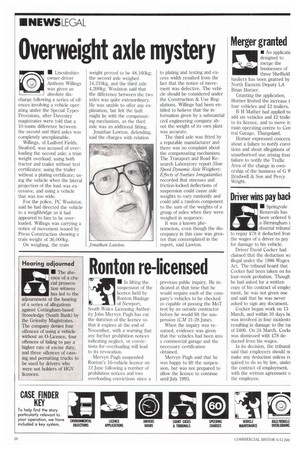Overweight axle mystery
Page 20

If you've noticed an error in this article please click here to report it so we can fix it.
• Lincolnshire owner-driver Anthony Willings was given an absolute discharge following a series of offences involving a vehicle operating under the Special Types Provisions, after Daventry magistrates were told that a 10-tonne difference between the second and third axles was completely unexplainable.
Willings, of Ladford Fields, Sleaford, was accused of overloading the second axle; a train weight overload; using both tractor and trailer without test certificates: using the trailer without a plating certificate; using the vehicle when the lateral projection of the load was excessive, and using a vehicle that was too wide.
For the police, PC Woolston said he had directed the vehicle to a weighbridge as it had appeared to him to be overloaded. Willings was carrying a notice of movement issued by Press Construction showing a train weight of 36,000kg.
On weighing, the train weight proved to be 48,160kg; the second axle weighed 14,210kg, and the third axle 4,200kg. Woolston said that the difference between the two axles was quite extraordinary. He was unable to offer any explanation, but felt the fault might lie with the compensating mechanism, as the third axle was an additional fitting.
Jonathan Lawton, defending, said the charges with relation to plating and testing and excess width resulted from the fact that the notice of movement was defective. The vehicle should be considered under the Construction & Use Regulations. Willings had been entitled to believe that the information given by a substantial civil engineering company about the weight of its own plant was accurate.
The third axle was fitted by a reputable manufacturer and there was no complaint about the compensating mechanism. The Transport and Road Research Laboratory report Slow Speed Dynamic Axle Weighers: Effects of Surface Irregularities recorded that stresses and friction-locked deflections of suspension could cause axle weights to vary randomly and could add a random component to the sum of the weights of a group of axles when they were weighed in sequence.
It was a known phenomenon, even though the discrepancy in this case was greater than contemplated in the report, said Lawton.




















































































































